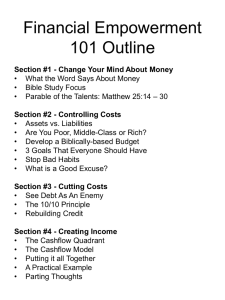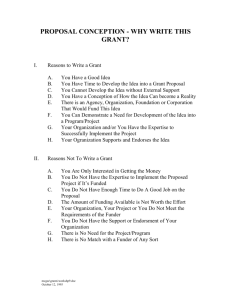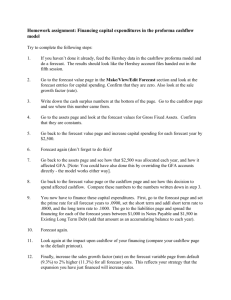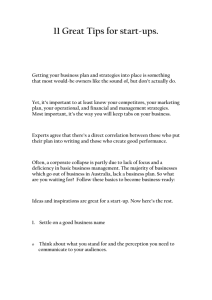Business Plan Template
advertisement
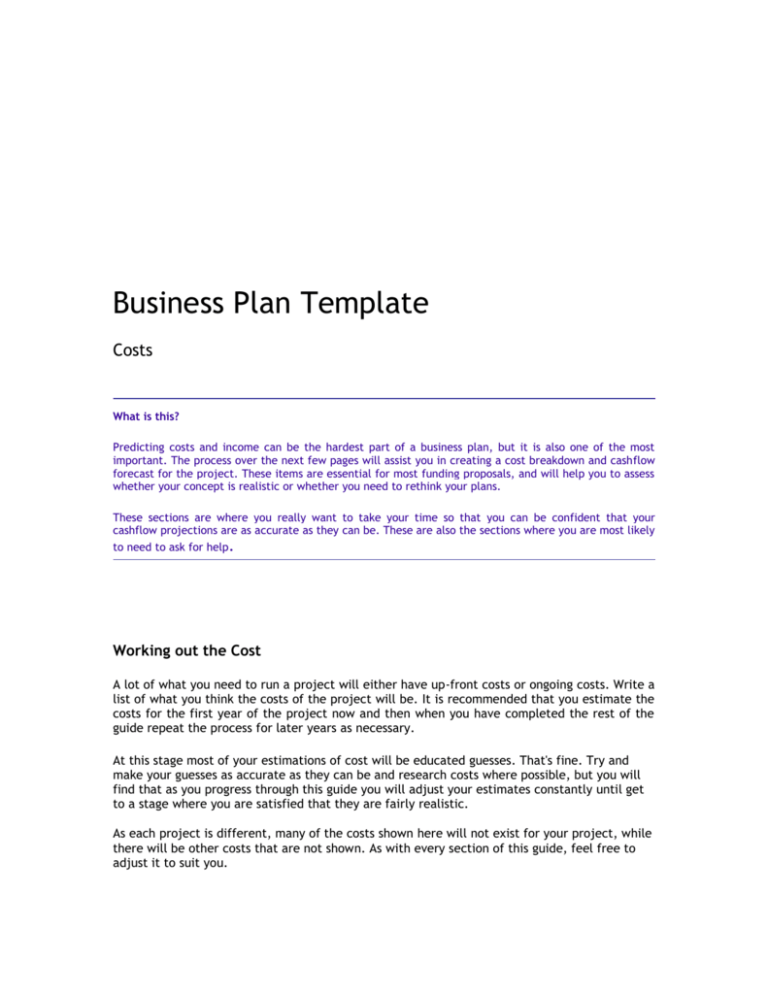
Business Plan Template Costs What is this? Predicting costs and income can be the hardest part of a business plan, but it is also one of the most important. The process over the next few pages will assist you in creating a cost breakdown and cashflow forecast for the project. These items are essential for most funding proposals, and will help you to assess whether your concept is realistic or whether you need to rethink your plans. These sections are where you really want to take your time so that you can be confident that your cashflow projections are as accurate as they can be. These are also the sections where you are most likely to need to ask for help. Working out the Cost A lot of what you need to run a project will either have up-front costs or ongoing costs. Write a list of what you think the costs of the project will be. It is recommended that you estimate the costs for the first year of the project now and then when you have completed the rest of the guide repeat the process for later years as necessary. At this stage most of your estimations of cost will be educated guesses. That's fine. Try and make your guesses as accurate as they can be and research costs where possible, but you will find that as you progress through this guide you will adjust your estimates constantly until get to a stage where you are satisfied that they are fairly realistic. As each project is different, many of the costs shown here will not exist for your project, while there will be other costs that are not shown. As with every section of this guide, feel free to adjust it to suit you. After you have made your initial estimates of how much your project will cost, stretch out those estimates so that you are now making an estimate of costs for each month of the project. Some costs (such as rent) are likely to be the same every month while others (such as power) will vary depending on the season. Other costs will change throughout the year or may be a one-off cost. If you take these changes fully into account it will give you a more accurate picture of what your costs will be each month. A spreadsheet to help calculate your costs can be found here (Microsoft Excel spreadsheet 585k). 2 Business Plan Template Income What is this? Whereas with the previous section you could make some educated guesses about what your costs will be, this is a section where you really need to do your homework. Your project will depend on being able to raise the amount of money you predict and if you are overly optimistic it could result in difficulty for your project in the future. Most funders will take your predicted income and costs into account when deciding how much to fund you, so an optimistic estimate of income could also result in less support from funding agencies. The best attitude to take in this section is a conservative one. Make sure that you really believe that the the amount of income you predict is realistic. Many good projects have collapsed because of their planners mistakenly believing that everyone else would be as passionate about the project as them. Sources of Income Where do you propose you will source the money for what you need? Some sources of money may be: Funding (such as grants) Fundraising (such as events designed to gather money – such as a community garage sale) Contracts for service Income that will be generated by the project Sponsorship Donations Cash provided by your organisation ‘In-kind’ donations Have you got any of this confirmed? How likely is it that you will be able to raise the rest? What will happen if you can’t? Most organisations need to generate their own income to ensure long term survival. How will you generate your income? Is it enough to pay for your service? Are you able to generate enough income from your project and still be able to deliver the social good you wish to provide? Who will you sell your goods or services to? Have you got a pricing structure? Will you charge different prices for different people? 3 If your organisation will not generate enough money to become self-sufficient how will you source the rest of the money you need? Is this source of funds secure? What will you do if it is not? You will need to show in your plan that you have relatively secure sources of income and contingency plans in case this does not eventuate. Unless you planning a project to fill a temporary need and then shut down you need to show how the project will survive in the long term. You need to show how you will generate enough income or ongoing funding in order to survive. You need to do some research and prove that your assumptions are justified. There are several ways to establish how realistic your assumptions are. If you are able, find a similar project or business and look at their finances. Look at your own history - if this project is a progression of work you have done before that will give you some indication. Market survey - Survey potential users of your service to establish whether they would use your service or buy your goods at the levels you think Gather statistics - Many business associations, government organisations and community groups have already gathered statistics which could help to prove your concept. Ask - get as much advice as possible from people with the experience to give you a truthful opinion. Predicting Income Starting from the same month as your predicted costs, make a monthly estimate of how much income you believe will be generated by your project. Remember that you are unlikely to be at full capacity to begin with and it may take months or years before you get there. It may be several months before you start generating income at all as you set up your project. Other events that may affect the income you generate are: The seasons - will certain seasons affect your in come generation, or should you reduce (or increase) your predictions based on the time of year? Holidays - How will Easter, Christmas, School Holidays affect your ability to earn? Short months - How many days will you actually be trading each month? Will this affect your income? Sporadic Sales - It may be that you do not have a constant income. Put the predicted income in the month where you think it will occur. Be realistic, a delay could be risky. Add other categories to show income that you are confident will occur. 4 Make sure that an explanation of your predictions are included as part of your business plan. Business Plan Template The Cashflow Forecast What is this? The cashflow forecast is one of the most important business planning tools. It allows you to work out whether your plan is realistic in the long term, and identifies any financial problems that may occur and when they will need to be addressed. It is also an essential component for many funding agreements as it shows that you have thought through the financial aspects of your project and are able to show what the results of any funding provided will be. A full cashflow forecast template can be downloaded here (Microsoft Excel document 585k). Putting it together You are now able to combine your income predictions with your cost predictions. This now shows how much money you are making or losing every month. 5 As shown above, the example project loses money in the first four months and does not start making a profit until later in the year. Overall this project makes a loss in the first year. This is not unusual, in fact most projects do not start making a profit for several years and there is no reason for concern. You may need to create cashflow forecasts for several years into the future before your income and cost become settled and you are able to see the long term financial outcome of your project. This is a good chance to have a look at your costs and see if any of them can be reduced, or if there are other ways of increasing your income. Goods and Services Tax It is vital that you take GST into account in your planning. In short - GST is a tax of 12.5% on most goods and services in New Zealand. If your organisation will receive more than $40,000 from any source you will be required to pay GST on most of your income, but you will be able to claim back the GST on many of your purchases. It is recommended that you gain a good understanding of GST or get help from someone who has. Some explanation is available through the Inland Revenue Department website. If GST is not taken into account in your cashflow forecast it can lead to large unexpected bills that will potentially damage your project. The cashflow forecast template accessible at the top of this page will calculate GST for you, but you still need to have a basic understanding of how this tax system works. 6 The example above shows the monthly amount to pay and claim from the IRD. You can choose to send in your GST returns either two monthly or six monthly. I strongly recommend choosing a two month period, as a longer period results in a larger bill which can be somewhat frightening when it arrives. Initial Investment The previous example also shows a summary at the bottom of the forecast. This shows how much money you have available at the start and end of each month. This example above shows a starting bank balance of $357, but the amount varies from group to group. Some groups can afford to put a large investment into a project while others have no cash to spare. Funding As the previous example shows, at one stage of the project the bank balance has gotten as low as -$24,152. As most banks won't allow you an overdraft of this size you need to find this money from elsewhere. For most community organisations the best option is fundraising, either through the local community or a funding agency. Most funding you will receive is GST inclusive, so you will end up having to pay some of your funding back to the IRD. Therefore when you look at the shortfall shown in your bank balance, remember to add 12.5% to that amount when applying for funding. ie: Although the example 7 shows a shortfall of $24,152, the project would have to raise funding of at least $27,171 (including GST) to keep the bank balance positive throughout the year. Completing the Plan You should now have the basis for a full business plan. You should now re-look over everything you have written, as there are likely to be changes to make. Business Planning is a fluid process, and you will generally make many adjustments to your plan before you are confident that it is realistic. It will never be perfect, but you should feel confident that it is an accurate representation of both your plan, and its likelihood of success. Good luck. 8 Funding Application Hints Attracting Funding Read the criteria for every funding application carefully. Be sure that the funder fits your needs and can provide the funding you need for the costs that you cannot meet. Find out what you have in common with the funder - what do they consider a good result. Every funder measures certain outcomes as their indicator of how well they are doing. If you can show that your goals match their goals you are more likely to be funded. Establish the funding deadline and make sure you can complete your application by that time - early if possible. Ask how long it will take between applying for funding and receiving money if you are successful. This will have a substantial impact on your planning. Ask the funder how good they think your chances of success are. This will help you with your risk management. 9 Find out how much detail the funder wants. Some funders want a one page summary, while others want as much detail as you can provide. Feel free to add appendixes to short applications, but be aware that the funder may not read them. Find out how strict the funder is on the filling out of application forms. Some require every box to be filled in full with no mistakes whatsoever, whereas others are satisfied with 'n/a' or 'see attached'. Be very clear about how much funding you are requesting, over what period and what it is for. Provide a cashflow forecast for EVERY year that you are requesting funding and potentially for the year after if that is needed by the funder. Be very clear about what will come out of your project. Who will your project help, how will it affect your community? Make sure that you are able to measure these results clearly. A project that creates a 'happier community' is hard to measure compared to a project that creates a 'happier community' by providing 4 community events and temporarily employing 4 people. Talk to the funding provider. Ask them how your plan can improve it's chances of receiving funding. Take any advice at face value. Funders have a lot of experience in this field - make use of it. Try not to put all of your eggs in one basket. You have not succeeded in attracting funding until the money is in your bank account. Most funders have a limited pool of money and even projects that they feel should be funded can be declined due to a lack of funds. Try not to be discouraged if you do not attract funding. Get advice from your funding provider about why you were declined and use that advice for any future applications. Multiple Sources of Funding Most community groups apply to several funding providers for the same project. Your chances of success with each funder will range from: If you do not fit the funding criteria for a project do not apply - it is a waste of your time as well as that of the funding provider. Make sure you take into account what will happen if you do not receive funding from a particular funding. Will you be able to find alternative funding or will you have to reduce the scale of (or even abandon) the project. 10 If you receive funding from any source make sure you let the other funding providers know. Success with one provider can actually increase your chances of success with others, but it may also reduce the amount they choose to fund you. Do not accept funding from two different funding providers for the same item. This is illegal and will ruin the chances of your group being funded again. It can be useful to use a cost breakdown as part of your business plan to show exactly where funding that is essential or that you are likely to receive will be spent. This also decreases the chance of 'double dipping' which will increase your chances of receiving funding. The cashflow forecast template provided on previous pages includes a cost breakdown template. You can also access it here. 11 Links Please press control-click on the link you would like to follow... Useful or Interesting Websites Canterbury Funding Providers Online Version of this document Canterbury Not-For-Profit Forum website Free Resources Cashflow Forecast and Cost Breakdown Template (Microsoft Excel 585k) Monthly Running Costs Template (Microsoft Excel 992k) 12
